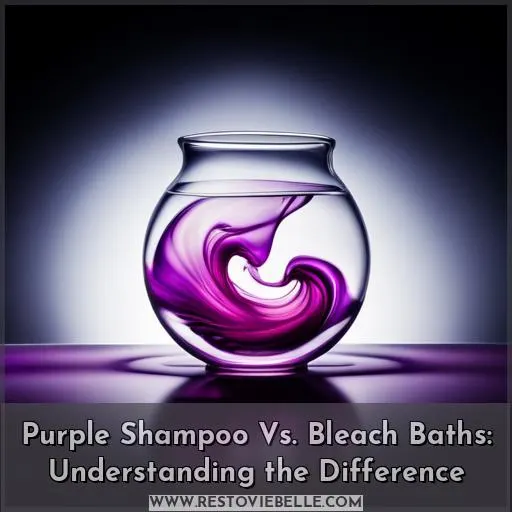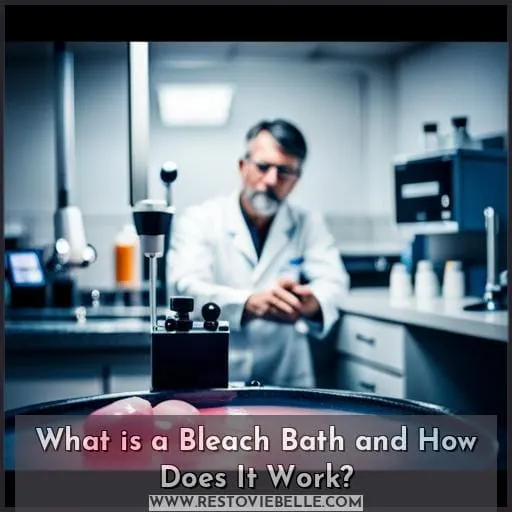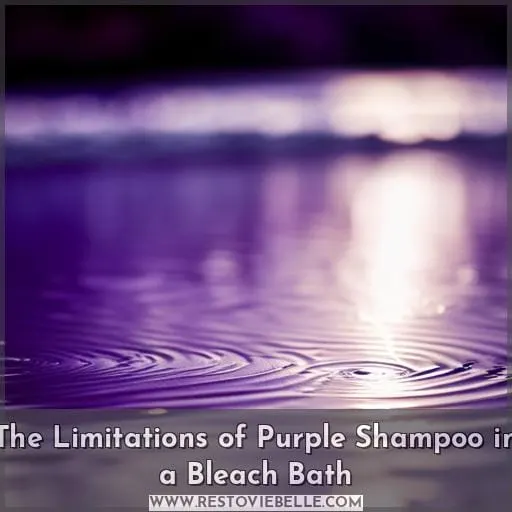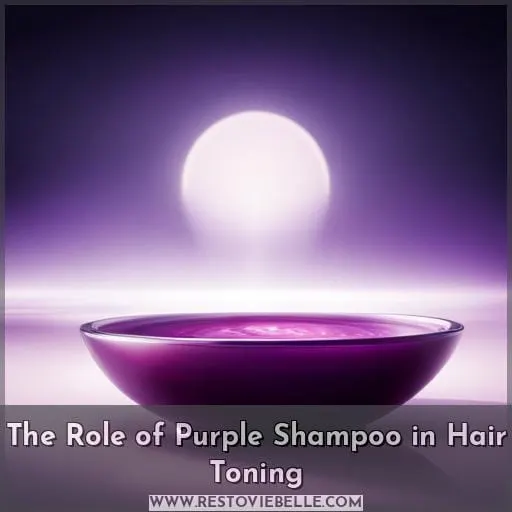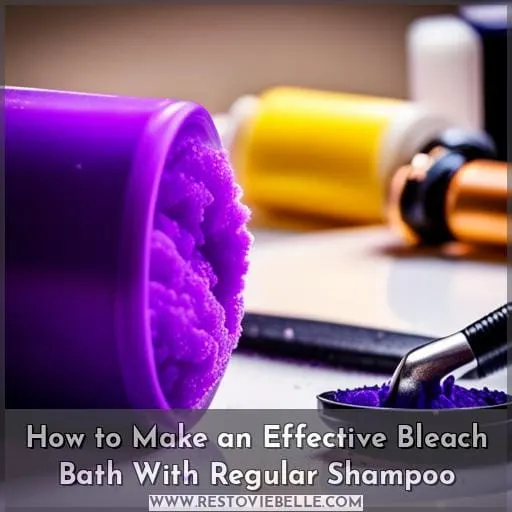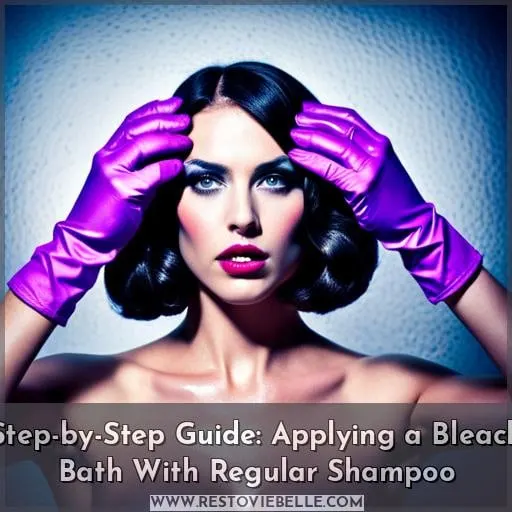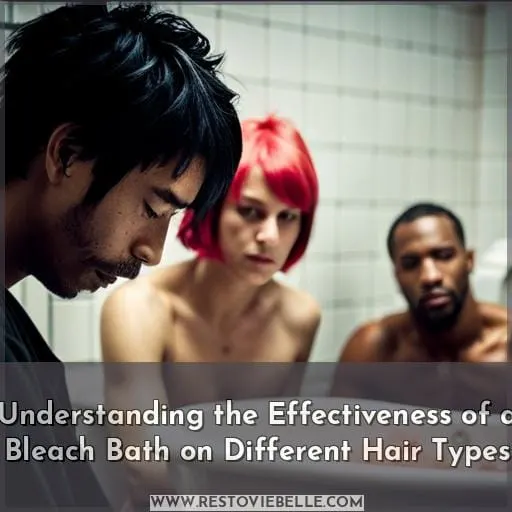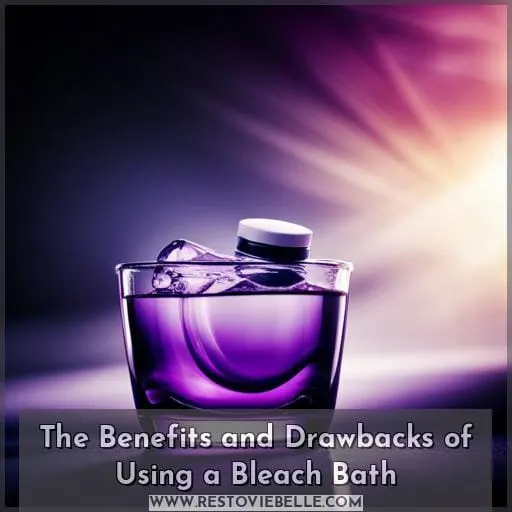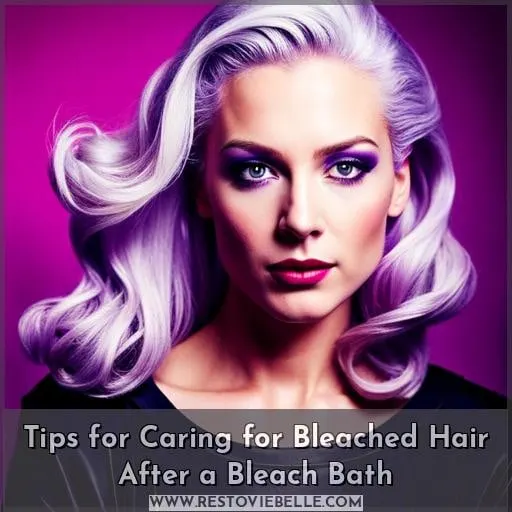This site is supported by our readers. We may earn a commission, at no cost to you, if you purchase through links.
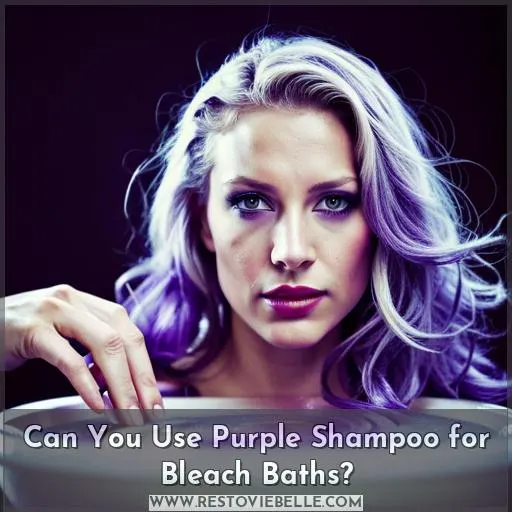 Are you ready to take your hair color game up a notch? If so, it’s time to explore the technique of bleach baths. This method is becoming increasingly popular among those who want lighter locks without needing harsh chemicals or bleaches.
Are you ready to take your hair color game up a notch? If so, it’s time to explore the technique of bleach baths. This method is becoming increasingly popular among those who want lighter locks without needing harsh chemicals or bleaches.
A bleach bath involves diluting regular bleaching agents with water and shampoo (often purple) in order to reduce their strength while still providing some degree of lightening effect. The end result depends heavily on the type and brand used. However, if done correctly, it can gently lift one’s natural hue by several shades without causing excessive damage or brassiness.
This is due to its milder potency compared with conventional dyes or products like hydrogen peroxide, which are more prone towards drying strands out than toning them down properly.
Table Of Contents
- Key Takeaways
- Purple Shampoo Vs. Bleach Baths: Understanding the Difference
- What is a Bleach Bath and How Does It Work?
- Can You Use Purple Shampoo for Bleach Baths?
- The Limitations of Purple Shampoo in a Bleach Bath
- The Role of Purple Shampoo in Hair Toning
- How to Make an Effective Bleach Bath With Regular Shampoo
- Step-by-Step Guide: Applying a Bleach Bath With Regular Shampoo
- Understanding the Effectiveness of a Bleach Bath on Different Hair Types
- The Benefits and Drawbacks of Using a Bleach Bath
- Tips for Caring for Bleached Hair After a Bleach Bath
- Conclusion
Key Takeaways
- Purple shampoo is not a substitute for a bleach bath, but it can be used afterward to tone and neutralize brassiness.
- Bleach baths are a technique for lightening natural hair color and correcting tone without harsh chemicals.
- Purple shampoo is more effective on darker hair for toning after lightening.
- Aftercare, including deep conditioning and the use of sulfate-free shampoo, is essential for maintaining the health of bleached hair.
Purple Shampoo Vs. Bleach Baths: Understanding the Difference
You may have heard of bleach baths for lightening your hair, but it’s important to understand the difference between using purple shampoo and a traditional bleach bath.
Purple shampoo is not an effective alternative to a regular bleach bath because its effects are diluted when mixed with other ingredients.
Bleach baths are best used for color correction and stripping out leftover dye or neutralizing unwanted tones, while purple shampoos can be used after bleaching to tone hair.
Additionally, it won’t help remove brassy tones from blonde hair like some people believe – this should only be done by toners specialized for brassiness removal.
When preparing for a safe bleach bath at home, make sure you use the right products in conjunction with developer and coconut oil as well as protective gear such as gloves and old clothes before applying the mixture on dampened strands evenly from roots to ends without dripping off too much product onto skin areas covered in Vaseline which acts as protection barrier against potential irritation caused by contact with chemicals found inside these mixtures of components made up of both natural ingredients alongside ones that require extra caution when dealing with them.
Due diligence must always come first prior to any type of beauty treatments one wishes to engage in, so they don’t end up regretting their decision afterwards.
Taking proper care post-bleach washing is also an essential part of the process so that the desired result can be achieved.
All said and done, if the instructions are followed properly, achieving the desired results shouldn’t prove to be too difficult of a job!
What is a Bleach Bath and How Does It Work?
A bleach bath is an effective way to lighten and tone hair while being less damaging than traditional bleaching. It requires shampoo, developer, and coconut oil, which are mixed together in a bottle.
Proper preparation includes washing your hair with clarifying shampoo and applying Vaseline on the skin around the head before beginning. The mixture should be applied from roots to ends using a tinting brush or gloved hand for even coverage.
Then, it should be left alone for several minutes or until it reaches the desired color. Afterward, rinse off thoroughly and follow up with a deep conditioning treatment.
Never use purple shampoo as part of this process since it gets diluted during application, rendering its effects useless. Instead, opt for silver or blue shampoos post-bleach wash to neutralize unwanted tones if necessary.
Safety precautions include wearing old clothes, ensuring good ventilation due to fumes created by bleach powder, keeping contact lenses out at all times during washing, and rinsing eyes with lukewarm water if any comes into contact with them.
Can You Use Purple Shampoo for Bleach Baths?
Although purple shampoo won’t make a difference due to dilution, it may still be used for bleach baths. However, regular shampoo is more effective in terms of lightening hair and removing unwanted tones.
For best results when using purple shampoo as an alternative, select one that’s specifically made for toning bleached hair or other dyed colors.
After a bleach bath treatment has been applied, the effects can last up to 20 days with proper aftercare such as deep conditioning and heat protection products. To maintain bleached hair color between treatments, use silver or blue shampoos/conditioners and avoid over-washing your locks, which strips away natural oils needed for healthy strands.
Toning should also be done to neutralize any yellow or orange hues left behind from the bleach bath process. Apply tints like blue or purple directly on dampened strands after rinsing out the mixture from roots to ends thoroughly with lukewarm water (not hot).
With practice comes perfection; take time experimenting between different ratios of ingredients until you find what works best!
The Limitations of Purple Shampoo in a Bleach Bath
While employing a lighter touch, the limitations of this particular product shouldn’t be underestimated. Purple shampoo may seem like an ideal solution for those looking to tone their hair with minimal damage, but it’s important to remember that its effectiveness can be limited when used in a bleach bath.
The dilution effect of mixing purple shampoo and developer means that it’s less effective than other products specifically designed for color correction or brassiness removal. Additionally, due to the lower concentration of active ingredients in purple shampoo compared to traditional toners, bleaching results will likely take longer and require more maintenance over time.
Although using purple shampoo as part of your bleach bath process could offer some benefits such as milder ammonia content or added conditioning properties from certain ingredients found within shampoos and conditioners, ultimately there are better solutions available if you’re looking for maximum color correction without damaging your hair any further than necessary.
The Role of Purple Shampoo in Hair Toning
Tone up your hair with purple shampoo post-bleaching for a refreshed look. Purple shampoo benefits bleached hair in many ways, from neutralizing unwanted tones to restoring moisture and shine. It’s an essential part of any good hair care routine after bleach baths or other lightening treatments.
To get the best results, it’s important to understand color theory and choose the right toning shade based on what you want to achieve. For example, blue-based shampoos are great for eliminating orange undertones while purple is used mainly for canceling out yellowish hues.
Applying purple shampoo correctly is also key; make sure not to leave it on too long as this can result in dullness and damage due to overprocessing! With proper knowledge of how toners work combined with regular use of high-quality products, you’ll be able to enjoy beautiful-looking locks without worrying about brassiness or fading colors!
How to Make an Effective Bleach Bath With Regular Shampoo
Making a successful bleach bath requires the right ingredients, tools, and technique! To get started, you need regular shampoo to mix with developer and coconut oil in a bottle.
Then, grab some gloves, an old towel, and a tinting brush before prepping your hair by washing it with clarifying shampoo.
Once ready for application, make sure to protect your skin from the chemicals using Vaseline or petroleum jelly.
Mix dilution ratios of 1 part bleach powder to 2 parts volume developer, depending on the desired outcome.
After rinsing off the mixture completely, use toners such as purple shampoo for orange tones or blue conditioner for yellow hues if needed.
Finally, don’t forget maintenance tips like using sulfate-free shampoos post-bleach baths and waiting at least 20 days between treatments.
Step-by-Step Guide: Applying a Bleach Bath With Regular Shampoo
Before beginning your bleach bath, it is important to properly prepare and mix the ingredients. Use a measuring cup for accuracy when mixing shampoo, developer, and coconut oil in a bowl or bottle. When applying the mixture on damp hair, use an old towel to protect the skin from contact with the bleach solution before combing through strands evenly.
The development time will vary depending on hair type and color; rinse after 10-20 minutes or as instructed by product directions, then move onto conditioning with a deep conditioner followed by toning if needed (purple shampoo should not be used).
Preparation and Mixing the Ingredients
Before you begin, make sure you have all the necessary ingredients and tools for a successful bleach bath. The mixing techniques will vary depending on your hair type and desired result. For effective dilution, mix shampoo with developer at a ratio of 1:2, and add coconut oil for extra moisture.
It’s important to take safety precautions, so wear protective gloves and old clothes. Apply Vaseline around areas where you don’t want the bleach mixture to touch your skin. After bleaching, you can use purple conditioner or toners instead of regular shampoo to tone any unwanted tones in your bleached hair.
Application on Damp Hair
Gently comb your hair and prepare to apply the bleach mixture onto damp locks. Take extra care when toning as purple shampoo may not be effective; use regular shampoo instead for better results. Apply the mixture from roots to ends, covering them all evenly with a tint brush or bowl applicator.
Don’t forget to clip up unbleached sections of hair or cover them with an old towel! Be sure to wear gloves and protective clothing at all times during application since bleach is strong enough to cause skin irritation if left on too long.
After rinsing, follow up with a deep conditioning treatment and sulfate-free maintenance shampoos for best effect in preserving color vibrancy!
Development Time and Rinse
Once you’ve applied the bleach bath mixture, the development time depends on your hair type and color. Generally, it can range from 15 to 30 minutes. During this time, check for any signs of irritation or a burning sensation.
These indicate that the product is too strong and needs to be washed off immediately.
When you’re finished developing, rinse with cold water until all traces of the bleach wash are gone. Then, you can use a deep conditioner. Avoid using purple shampoo during development because its effects will become diluted when mixed with other products in a bleaching solution.
Instead, use toner after rinsing for the desired results, such as a purple toner to neutralize yellow tones.
For maintenance, it’s recommended to wait at least 20 days between treatments. Additionally, use sulfate-free shampoos after bleach baths and make sure to have regular conditioning sessions.
Conditioning and Toning (if Needed)
Reap the rewards of your hard work by conditioning and toning your hair to achieve those perfect results!
Start with applying a deep conditioner, then use sulfate-free shampoo for maintenance.
If you need to tone it down further, use purple shampoo or other methods like blue or silver shampoos on wet strands. This will help neutralize any unwanted tones that may have been created during the bleach bath process.
And don’t forget aftercare tips such as using heat protectant before styling and avoiding too many treatments in a row!
With dedication and practice, you’ll be able to master the art of bleaching in no time while enjoying all its amazing benefits without worrying about damage caused by harsh chemicals typically used with traditional bleaching processes.
Understanding the Effectiveness of a Bleach Bath on Different Hair Types
Are you looking to lighten your hair with a bleach bath? Depending on the hair type, different techniques may be necessary to achieve optimal results. From blonde and dark hair to brittle or natural color, understanding how bleach baths work differently on various types of locks is essential to ensure you get the desired outcome without damaging your tresses.
Bleach Bath for Lightened or Blonde Hair
If you already have lightened or blonde hair, a bleach bath can help refresh your color and add vibrancy back into your locks. To maintain the look, use a moisturizing shampoo instead of purple shampoo alternatives.
Then follow up with clarifying shampoos every two weeks to remove product build-up and achieve optimal results. For toning techniques, apply purple conditioner onto damp hair for 5 minutes after each wash.
This helps neutralize unwanted tones caused by bleaching or other chemical treatments on the hair strands.
Lastly, remember safety is key when it comes to bleach baths. Ensure proper ventilation area with no contact lenses present during the application process!
Bleach Bath for Dark Hair
Dark hair can benefit from a bleach bath’s gentle lightening power, perfect for popping in subtle highlights and softening stubborn hues. Purple shampoo benefits are key to keeping it healthy while toning out unwanted brassy tones after bleaching.
It is essential to prioritize bleach bath safety by always patch testing before application and using Vaseline on the skin to protect it.
Proper toning techniques should be used, such as using a blue toner for orange undertones or purple for yellow ones after bleaching. To maintain the health and vibrancy of your locks, it is recommended to use deep conditioners constantly and sulfate-free shampoos when needed.
This will ensure that your hair remains healthy without compromising its color vibrancy.
Bleach Bath for Brittle or Fragile Hair
Be mindful of your delicate tresses when considering a bleach bath to lighten hair, as it could cause further breakage. For brittle or fragile hair, a milder alternative such as coconut oil bleaching may be more suitable.
Purple shampoo is also another option for toning unwanted hues; however, it won’t provide the same results due to dilution in water.
To protect and nourish your hair texture while bleaching, opt for sulfate-free shampoos and deep conditioners specially formulated for color-treated locks. Additionally, use heat protection products before styling with heat tools to prevent damage from occurring over time.
Bleach Bath for Natural Hair Color
For those looking to lighten their natural hair color, a bleach bath is an ideal option for subtle highlights without damaging effects. DIYers can use coconut oil, shampoo, and developer mix to create the desired effect.
Hair should be washed with clarifying shampoo first before application of the mixture on damp hair from roots to ends. It’s important to protect the skin with Vaseline and wear old clothes while doing this process.
Toners may help neutralize unwanted tones post-bleaching; sulfate-free shampoos help maintain bleached locks too! Regular deep conditioning also helps keep strands healthy, as well as using purple or silver shampoos instead of harsh purple alternatives.
Taking care after each treatment will ensure the best results every time!
Bleach Bath for Hair Texture
Experience the difference a bleach bath can make to your hair’s texture! Achieving soft, bouncy hair with minimal damage requires careful consideration of your current tresses. If you have coarse or thick strands, using purple shampoo alternatives is recommended as it tends to be less drying than traditional bleaching methods.
For best results, incorporate coconut oil into the bleach mixture to help protect and nourish your locks while lightening them up.
Post-bleach washing maintenance involves avoiding brassiness by using sulfate-free shampoos specifically formulated for bleached hair.
With proper care, you can enjoy beautiful blonde tresses without worrying about the damaging effects of regular bleaching techniques.
The Benefits and Drawbacks of Using a Bleach Bath
A bleach bath is a gentle alternative to traditional hair bleaching that can be used to lighten or correct unwanted hair tones. While it offers many benefits, such as being less damaging than regular bleaching and removing leftover dye, there are also some drawbacks and limitations you should consider before attempting the process.
Benefits of a Bleach Bath
Unlock a whole new world of hair possibilities with the help of a bleach bath! Bleach baths can offer an alternative to traditional bleaching, providing gentle lightening up to two shades. These treatments are also great for removing unwanted tones and correcting dyed colors.
With the proper ingredients and tools, you can achieve soft hues that last longer than dyeing your hair. Purple shampoo is effective after treatment as it helps maintain desired tones while protecting against brassiness or fading.
Drawbacks and Limitations of a Bleach Bath
Although a bleach bath can be less damaging than traditional bleaching, it’s important to recognize the drawbacks and limitations that come with using this method.
Purple shampoo won’t work effectively as it gets diluted in the mixture, while color correction may take more time and effort.
Hair lightening is limited to just 1-2 shades due to its gentleness, so achieving extreme hair lightening results like platinum or blonde will not be possible.
Additionally, purple shampoo should only be used post-bleaching for toning unwanted tones – regular shampoo is necessary for effective bleach baths instead.
Finally, risks such as skin irritation are still present when using a bleach bath; therefore caution should always be taken before carrying out any dyeing process on your hair!
Tips for Caring for Bleached Hair After a Bleach Bath
To keep your hair looking beautiful after a bleach bath, it’s important to follow the right aftercare and maintenance steps.
- Hair Hydration: Use a deep conditioner or nourishing hair mask weekly to restore moisture back into bleached locks.
- Color Maintenance: It’s best to use color-safe shampoos that won’t strip away dyes from your hair too quickly, preventing any further damage and fading of color over time.
- Heat Protection: Using heat protectants helps prevent dryness caused by styling tools such as blowdryers or curling irons on already fragile strands from bleach baths.
- Purple Shampoo for Tone Neutralization: This type of shampoo can be used once per week in between regular washes for toning down brassiness, especially if you have blonde highlights.
- Deep Conditioning: Opt for deep conditioning treatments at least twice per month, which will add much-needed nutrients and strength back into bleached-out tresses.
With these tips in mind, you’ll be able to give newly lightened locks the extra love they need so you can achieve stunning results safely!
Conclusion
A bleach bath can be an effective way to lighten and even out hair color without the damaging effects of traditional bleaching. However, using purple shampoo for bleach baths is not recommended due to its lack of effectiveness.
For example, a woman with natural brown hair wanted to lighten her hair a few shades. She tried using purple shampoo for her bleach bath but found that it was not effective in lightening her hair. Instead, she used regular shampoo and developer with coconut oil to create a successful bleach bath and achieved her desired result.
To ensure the best results, it’s important to understand the type and condition of hair, as well as the specific ingredients and tools needed for a successful bleach bath. With the right preparation and maintenance, a bleach bath can be an effective way to lighten hair without the damaging effects of regular bleaching.
